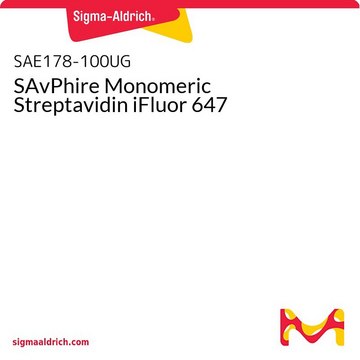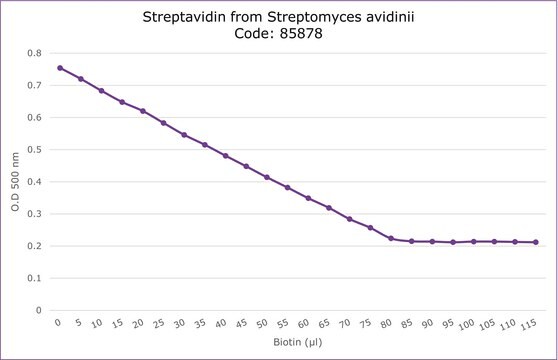S2438
Streptavidin−Peroxidase Polymer, Ultrasensitive
Synonyme(s) :
Highly sensitive Streptavidin−Peroxidase
Se connecterpour consulter vos tarifs contractuels et ceux de votre entreprise/organisme
About This Item
Code UNSPSC :
12352202
Nomenclature NACRES :
NA.32
Produits recommandés
Forme
buffered aqueous solution
Niveau de qualité
Conditions d'expédition
wet ice
Température de stockage
−20°C
Description générale
Activated streptavidin (SA) and horseradish peroxidase (HRP) are covalently conjugated to a polymer backbone. Multiple active biomolecules on each polymer chain increase the biotin binding capacity and amplify the peroxidase enzyme signal.
Spécificité
Biotinylated biomolecules.
Application
Detection of biotinylated proteins and nucleic acids and other biomolecules.
Suitable use in Western blotting and ELISA and for detecting surface antigens in immunohistochemistry and immunocytochemistry.
Suitable use in Western blotting and ELISA and for detecting surface antigens in immunohistochemistry and immunocytochemistry.
Forme physique
Supplied as an 1.0 mg/ml solution in 0.01 M sodium phosphate, 0.15 M sodium chloride, 50% glycerol, stabilizer and preservative, pH 7.4.
Code de la classe de stockage
10 - Combustible liquids
Classe de danger pour l'eau (WGK)
WGK 1
Point d'éclair (°F)
Not applicable
Point d'éclair (°C)
Not applicable
Certificats d'analyse (COA)
Recherchez un Certificats d'analyse (COA) en saisissant le numéro de lot du produit. Les numéros de lot figurent sur l'étiquette du produit après les mots "Lot" ou "Batch".
Déjà en possession de ce produit ?
Retrouvez la documentation relative aux produits que vous avez récemment achetés dans la Bibliothèque de documents.
Les clients ont également consulté
Natalia Gruba et al.
International journal of molecular sciences, 20(7) (2019-03-31)
Kallikrein 13 (KLK13) was first identified as an enzyme that is downregulated in a subset of breast tumors. This serine protease has since been implicated in a number of pathological processes including ovarian, lung and gastric cancers. Here we report
Faruk Can et al.
Bioelectrochemistry (Amsterdam, Netherlands), 135, 107553-107553 (2020-05-23)
Applications of molecular techniques to elucidate identity or function using biomarkers still remain highly empirical and biosensors are no exception. In the present study, target-specific oligonucleotide probes for E. coli K12 were designed thermodynamically and applied in an electrochemical DNA
Jaclyn C Law et al.
Journal of immunology (Baltimore, Md. : 1950), 206(1), 37-50 (2020-11-20)
There is a pressing need for an in-depth understanding of immunity to SARS-CoV-2. In this study, we investigated human T cell recall responses to fully glycosylated spike trimer, recombinant N protein, as well as to S, N, M, and E
Stefan Kaluz et al.
Biochemical and biophysical research communications, 370(4), 613-618 (2008-04-12)
The hypoxia-inducible factor (HIF) activates transcription via binding to the highly variable hypoxia-responsive elements (HREs). All hypoxia-inducible constructs described to date utilize multimers of naturally occurring HREs. Here, we describe the rational design of minimal hypoxia-inducible enhancers, conceptually equivalent to
Mariana Resende et al.
Immunology, 159(1), 121-129 (2019-10-14)
The transcription factor hypoxia-inducible factor-1 alpha (HIF-1α) is a key regulator of the response and function of myeloid cells in hypoxic and inflammatory microenvironments. To define the role of HIF-1α in tuberculosis, the progression of aerosol Mycobacterium tuberculosis infection was
Notre équipe de scientifiques dispose d'une expérience dans tous les secteurs de la recherche, notamment en sciences de la vie, science des matériaux, synthèse chimique, chromatographie, analyse et dans de nombreux autres domaines..
Contacter notre Service technique













